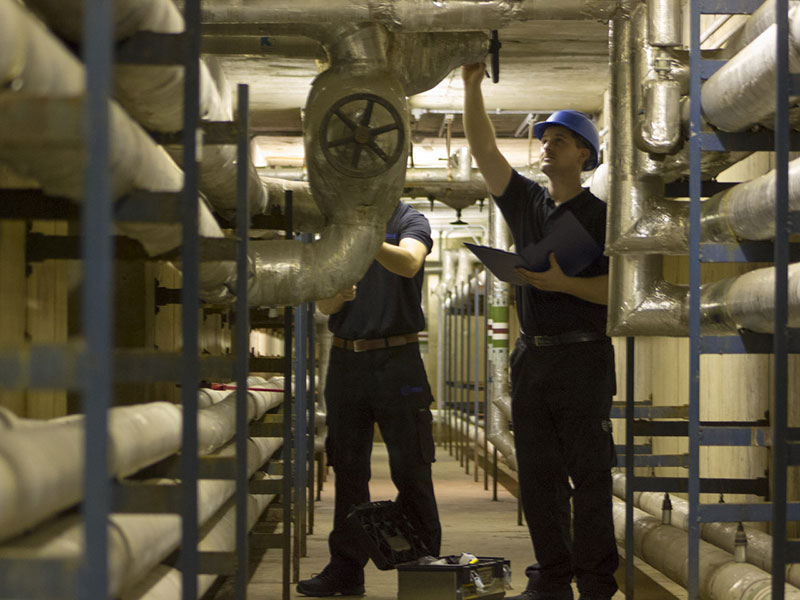How do I write an asbestos management plan?
When asbestos is disturbed, it can become extremely dangerous. Prolonged exposure to asbestos can lead to major and even fatal health conditions decades later. Workers in certain fields, like construction, are more prone to asbestos exposure than other types of employees, too.
If asbestos is on the premises of a non-residential building, the law requires certain precautions to be taken. These rules help keep anyone on the premises safe, from visitors to the workers who have to deal directly with asbestos.
If asbestos is on the premises, the Control of Asbestos Regulations 2012 requires a management plan and an asbestos register. Repair or maintenance work can only take place once these documents are complete.
What is an asbestos management plan?
An asbestos management plan describes the process for managing asbestos risk on the premises. Part of that is explaining how to avoid disturbing materials containing asbestos. Additionally, the plan details who manages asbestos on the premises.
The document may be handwritten or typed. Storing the records electronically makes it easy to update them as needed.
Regardless of how it’s written up, the plan must be accessible to anyone who may need it. That includes staff, tradesmen, and visitors.
Whose responsibility is it to complete and manage the plan?
If you have a legal responsibility to repair or maintain the premises, you’re the Duty Holder. That means managing asbestos on the premises is your legal duty. That may be the building manager or landlord, for example.
You may also be the Duty Holder if:
- You’re the property or building owner.
- You’re responsible for the property through a contract or agreement.
- You’re in control of the property even if there’s no formal contract or agreement.
It’s a requirement for the Duty Holder of a non-residential building to maintain an asbestos register and plan.
How do I know if the property contains asbestos?
If you’re unsure if the property contains asbestos, the first thing to do is to determine if it is present. Start by checking the year the building was built. Buildings constructed before 2000 could likely contain asbestos. In this case, further investigation may be required. This could include:
- Learning about the history of the building.
- Looking for a record that says the building contains asbestos.
- Scheduling an inspection to determine if there’s asbestos.
You can also have an accredited asbestos surveyor carry out an asbestos management survey. The survey will have details about the condition, location, and type of asbestos materials on the premises. This can guide the Duty Holder to create the asbestos management plan. Alternatively, some surveying companies will create a plan for you.
It’s important to understand that an asbestos survey is not the same as an asbestos management plan. A survey will tell you where asbestos is located, the type of asbestos present, how much there is, and the condition of the materials. It won’t have information about managing risk. You’ll then use the survey’s findings to create a register and management plan.
What is an asbestos register and how does it differ from an asbestos management plan?
The asbestos register is part of the management plan. It details the location of asbestos materials on the premises. It also describes the condition of the materials.
The asbestos register details where asbestos is located and its condition. The management plan details how the risks from asbestos materials are handled. Both the plan and the register have to be regularly monitored.
What should the asbestos register contain?
To create an asbestos register yourself, you’ll first need to do the following:
- Get a copy of the building plans. If there aren’t any you can find, draw the building’s layout yourself.
- Walk around the building. Find the materials that may contain asbestos.
- On the building plan, mark down the location of any materials that may contain asbestos.
Also include any locations that you weren’t able to access, like roofing or wall cavities. The idea is that asbestos may be present in those areas, so you don’t want to leave them off the register.
Most importantly, do not disturb any materials that may contain asbestos. If you’re not comfortable inspecting the building yourself, you can appoint a professional to carry out the inspection.
Compiling the asbestos register records
Now it’s time to prepare the records for the asbestos register. In addition to the location of the asbestos, include the following:
- The type of asbestos present.
- The name of the material it’s in.
- The condition of the asbestos material.
Make sure that the records are written neatly and clearly. They have to be easily understood by anyone who wants or needs to access them.
Sign and date the asbestos register when it’s complete.
What should the asbestos management plan contain?
An asbestos management plan includes a lot of information, but it must be simple and easy to understand. Here’s all the information that an asbestos management plan should include:
Asbestos register
The management plan must accompany the asbestos register.
Building or premises name
Name the premises. For example, “Robin Road High School.”
Key people
The plan must include information about the premises manager and the Duty Holder. Sometimes, these will be two different people. For example, the premises manager may be the person with budgetary and managerial responsibilities. The Duty Holder (or site manager) may be specifically delegated to handle asbestos on the premises.
For whoever is mentioned in this section, include their full name and their role.
Creation and review dates
List the creation date of the asbestos management plan, as well as the last review date.
Location of the asbestos register
The asbestos register should be available to anyone on the premises who may come in contact with asbestos materials. In this section, clarify where the register can be found. (It’s common for the management plan and the register to be stored together.)
Non-maintenance staff
In this section, clarify the non-maintenance employees who should know where the asbestos materials are and have access to them. For example, you may write, “Due to the location of asbestos on-site, access is limited to the site manager.”
For all other staff, you can decide how to communicate where asbestos is located and which parts of the building should remain undisturbed.
System for safely working near asbestos
This part of the plan details how workers should avoid accidentally disturbing asbestos materials. It should include a step for checking the asbestos register before work begins, too.
This section also includes a list of where warning labels have been placed. Labels are not mandatory, but if you have labeled certain areas with warnings, list them here.
Training
In this section, list who has taken asbestos training and the date when the training occurred.
Risk assessments and monitoring
In this section, detail how often monitoring will occur. It may be as simple as, “All areas containing asbestos will be monitored on an annual basis.” Or, you may go into more detail. For example, some materials may need more frequent monitoring.
Whatever the monitoring arrangements are, detail them here.
Planned work
The plan should include information about planned work that may impact asbestos materials.
Signature and date
The Duty Holder should sign and date the asbestos management plan at the bottom.
Who needs to know if there’s asbestos on the premises?
When the asbestos register and management plan are finished, the Duty Holder should inform others of the presence of asbestos.
Employees and maintenance staff must be informed. They should also be told how to report problems, should any arise. Also, anyone who is going to do work on the building, like contractors, engineers, or surveyors, must be shown the register and management plan before work begins.
It’s smart to put warning labels on materials that do or may contain asbestos. This reduces the chance of those materials being disturbed.
What’s the best review schedule for the asbestos management plan?
Monitoring of asbestos materials should take place every six to 12 months. When that happens, the asbestos register and management plan should receive an update. The update should note any deterioration of asbestos materials.
This is what occurs during a review:
- An inspection to check the condition of asbestos materials.
- Deletion of information from the register when asbestos is removed.
- Details added about new areas surveyed and/or new asbestos materials discovered.
- Details added about the deterioration of asbestos materials.
Outside of that time frame, work may affect the condition of the asbestos materials. Update the plan if this occurs. Also, certain areas may need more frequent monitoring than others.
At the least, though, the plan should be reviewed and updated once a year.
There’s no amount of asbestos exposure that’s considered safe. Many of the health conditions that result from long-term asbestos exposure have no cure, often requiring aggressive treatment.
Knowing where asbestos is located and how to keep everyone on the premises safe is absolutely necessary.
Final thoughts
This article provides a brief overview of how to write an asbestos management plan. However, we strongly recommend entrusting the creation of such a critical and potentially life-saving document to a qualified professional with expertise in asbestos and its management. By employing the services of a UKAS-accredited asbestos organisation, you will be safe in the knowledge that you have a thorough asbestos management plan in place that will ensure the safety of everyone whom you are responsible for.
Contact us today for help surveying your building so you can create an effective asbestos management plan. We can also help you put together a custom asbestos management plan.

Written by Mark Carter
Mark Carter is a renowned expert in asbestos management, offering clients vital guidance on compliance and safety. His expertise is invaluable for navigating asbestos regulations, ensuring both safety and legal adherence. Mark's role is central in providing effective asbestos-related solutions, helping clients achieve their business objectives with an emphasis on regulatory compliance and safety in asbestos management.

